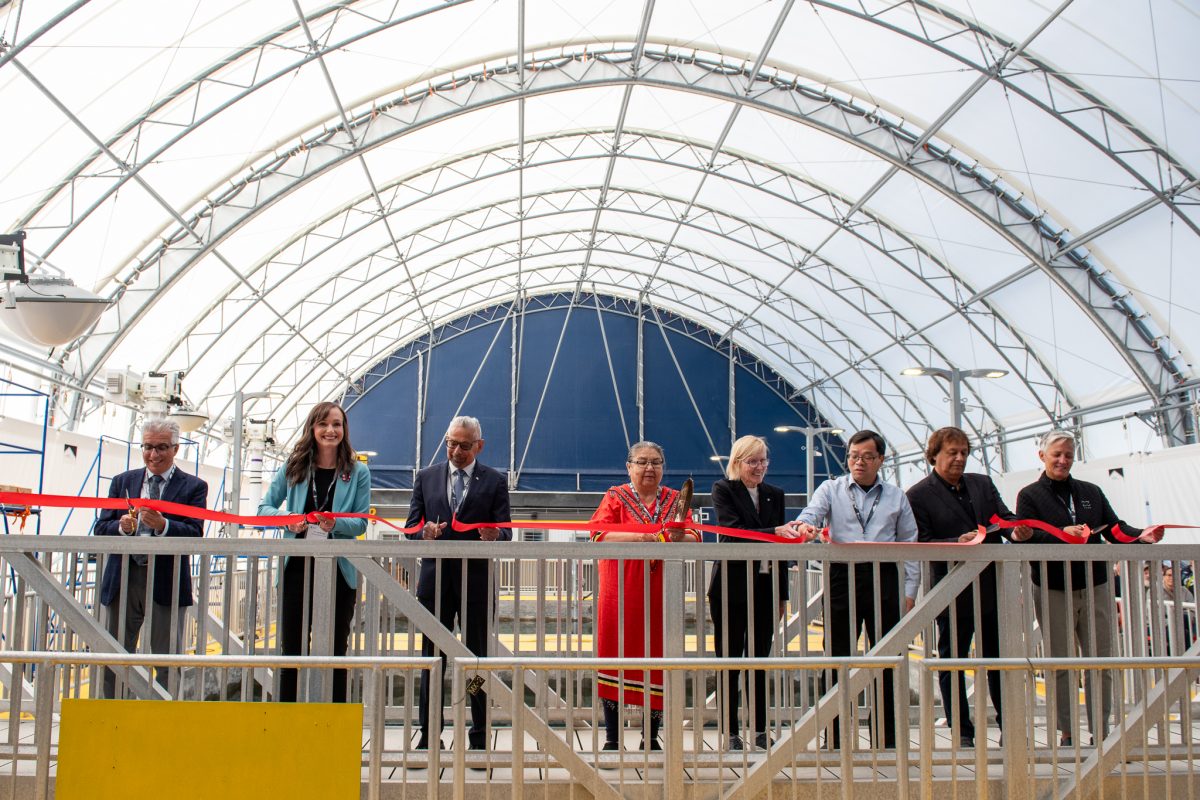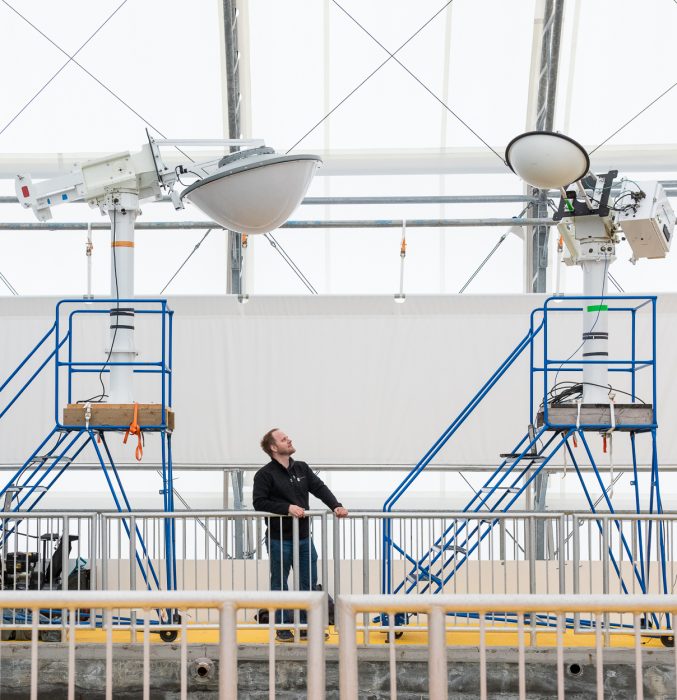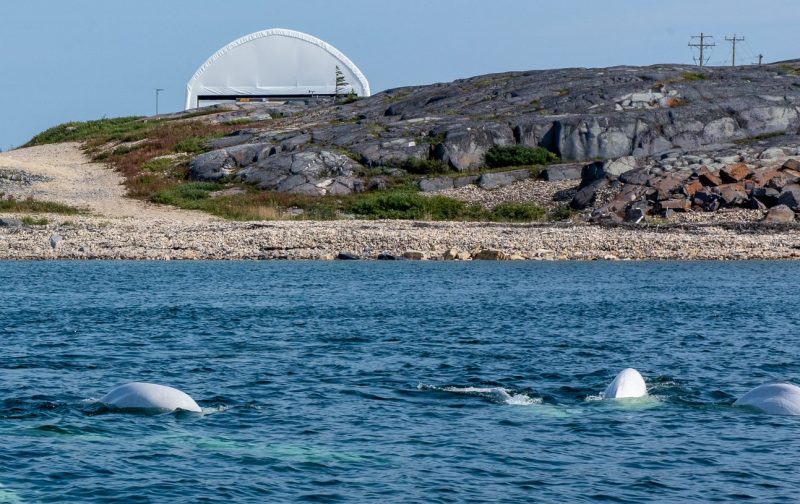
UM and community leaders cut the ribbon on the new Churchill Marine Observatory.
Churchill Marine Observatory opens for Arctic climate and environmental research
Cutting-edge facility to enhance Manitoba and Canada’s position as a world leader in Arctic research
On Tuesday, August 27, 2024 the UM Centre for Earth Observation Science celebrated the grand opening of the Churchill Marine Observatory (CMO), led by Project Lead Dr. Feiyue Wang and Co-Lead Dr. CJ Mundy.
The CMO is a globally unique multidisciplinary research facility located adjacent to North America’s only Arctic deep-water port with rail access to the south. Working together with the town of Churchill and communities in the region, CMO researchers study the challenges and opportunities associated with the rapidly changing Arctic Ocean such as increased marine shipping in Hudson Bay and throughout the Arctic.
“For many years the University of Manitoba has been building partnerships with Inuit and First Nations communities and organizations throughout the Arctic to further our collective understanding of the challenges and opportunities climate change will bring our province,” says Dr. Michael Benarroch, UM President and Vice-Chancellor.
“We have been asking how we can ensure our work brings truly positive benefits to northern communities through responsible economic developments and environmental protections. Now, the Churchill Marine Observatory will provide answers to these and many other questions. This unique lab comes at a pivotal moment in our province’s history and UM is proud and excited to be a driving force behind it. We thank our many partners who helped make it a reality.”
Community leaders from Northern Manitoba and the Kivalliq region of Nunavut along with government representatives attended the grand opening event, including the Honourable Renee Cable, Minister of Advanced Education and Training, His Worship Simionie Sammurtok, Mayor of Chesterfield Inlet and His Worship Mike Spence, Mayor of Churchill.
The facility is made possible by a combined investment of $45 million from the Canada Foundation for Innovation (CFI), the Provinces of Manitoba and Alberta along with many other partners.
“Congratulations to the University of Manitoba on the grand opening of the Churchill Marine Observatory,” says Hon. Dan Vandal, Minister of PrairiesCan, Governent of Canada.
“It is an excellent addition to the Town of Churchill and offers Canada new insights about extreme weather and climate change. The benefits of this multi-disciplinary, globally unique facility offer tremendous research opportunities for Manitoba and demonstrates the potential for success when partners come together.”
“The Churchill Marine Observatory is a testament to the ingenuity, dedication, and perseverance of the University of Manitoba administration, faculty and staff who are leading a new era in Arctic research,” says Hon. Renée Cable.
“This project will bolster our fight against climate change, support sustainable and green economic growth and contribute to protecting our planet’s fragile and connected ecosystems. It also positions Manitoba as a leader in Arctic research and will attract talent from around the world.”
To facilitate broader community engagement with UM, a Community Knowledge Exchange Panel led by Mario Pinto, UM Vice-President (Research & International) took place at the Churchill Community Centre. Open to all, the panel included CMO Co-Lead CJ Mundy, Mayor Spence, and representatives for the Arctic Gateway Group, Churchill Chamber of Commerce, and the community of Churchill.
CMO will also help host the Churchill Barber Science Symposium, a community-engaged event that will include an evening panel discussion followed by a series presentations highlighting expert submitted research. The event is additionally supported by the Town of Churchill, Polar Bear International, and the Churchill Northern Studies Centre.
“Community leaders across the region have initiated discussions with UM researchers to take control of their socio-economic futures in light of changing climate, and pressure from global supply chain instability,” said Dr. Mario Pinto, Vice-President (Research & International). “Our work at CMO is informed and inspired by the Indigenous worldview, aligning with UM strategies for social and economic reconciliation and research by with and for Indigenous Peoples.”
Research impacts of the facility
The research infrastructure of the CMO includes three core facilities.

Dustin Isleifson, director of CEOS, at the Ocean-Sea Ice Mesocosm facility
The Ocean-Sea Ice Mesocosm (OSIM) incorporates outdoor pools used to study processes across the ocean, sea ice and seawater interface, as well as the detection and mitigation of contaminants associated with marine shipping.
The Environmental Observing system is a series of taut-line moorings located along the main shipping channels across Hudson Bay providing a state-of-the-art monitoring system used for larger studies in the Arctic environment.
The third core facility is the Research Vessel which is operated in partnership with the Arctic Research Foundation, to facilitate ship-based studies around Hudson Bay.
“The research happening at the Churchill Marine Observatory is helping Canada respond to the pressing challenges caused by a changing Arctic,” said Roseann O’Reilly Runte, President and CEO of the Canada Foundation for Innovation. “By supporting one-of-a-kind facilities, the CFI is giving researchers from around the globe unprecedented access to the tools they need to collaborate on solutions that will benefit people everywhere.”
A dedicated atmospheric station and radar systems at the CMO are now online, providing nearly continuous observation of changes in the air and sea ice at the facility and in the nearby area. Several research projects with international participation are scheduled to take place at the CMO starting November 2024.
“UM has long been a global leader in Arctic research with a specific focus on climate change and its effects,” said Dr. Feiyue Wang, Project Lead of the CMO and Associate Dean, Research and Innovation at the Clayton H. Riddell Faculty of Environment, Earth, and Resources.
“An ice-free Hudson Bay and a summer ice-free Arctic Ocean is a future we don’t know much about – a future we are approaching more rapidly than expected. At the CMO our research is intensifying around scientific, technological and socio-environmental issues as the Arctic opens, for better or worse, as never before in the modern human history.”
The CMO was made possible thanks to the vision and leadership of the late Dr. David Barber, who is honoured with a plaque at the new facility. His tireless work helped to place Canada at the forefront of Arctic research and established opportunities for innumerable students and researchers to better understand the impacts of the rapidly changing Arctic and beyond.
UM research partnerships in Churchill are an example of the university’s commitment to taking action on climate change. In the coming weeks, UM Today will feature in-depth stories and profiles about CMO and its world-class researchers, including Dr. Feiyue Wang on President Benarroch’s What’s the Big Idea podcast airing Oct.9.

Beluga whales swim in the waters adjacent to the Churchill Marine Observatory.
Research at the University of Manitoba is partially supported by funding from the Government of Canada Research Support Fund.






